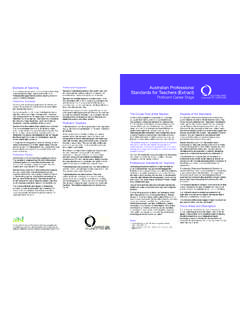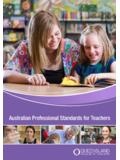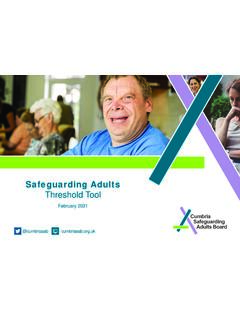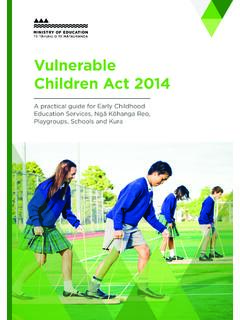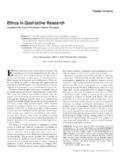Transcription of A Guideline for Queensland Teachers - QCT
1 May 2016 (updated July 2017)Professional Boundaries: A Guideline for Queensland Teachers2 Queensland was the first state in Australia to establish a system of registration for Teachers in both public and private schools. Registration was initially voluntary in 1973, and became mandatory in registration protects the public and the profession from unqualified and, in certain cases, unsuitable, persons seeking to teach. It serves as a means of ensuring the requisite standards for entry to and ongoing practice in the profession are Queensland College of Teachers (QCT) registration framework is among the most progressive in Australia. Queensland Teachers are held in high esteem world wide, due to the registration requirements they must satisfy to be admitted to the profession by the Education ( Queensland College of Teachers ) Act 2005 and the Education ( Queensland College of Teachers ) Regulation 2016 provide the legislative framework for regulating the teaching profession in QCTThe QCT is the regulatory body for the teaching profession in Queensland .
2 It is principally funded by Queensland Teachers . The QCT works in the best interests of schools, the public and the profession. It protects students by ensuring Teachers approved to teach in Queensland schools are qualified, current in their practice and suitable to Purpose Uphold the standards of the teaching profession Maintain public confidence in the teaching profession Protect the public & the professionOur VisionQuality Regulation Quality TeachersThe main functions of the QCT are: accrediting and monitoring initial teacher education programs granting teacher registration or permission to teach to eligible persons developing and applying professional standards for entry to, and continuing membership of, the teaching profession keeping a register of, and records relating to, approved Teachers and providing data from the register to other persons, as required or permitted under the Act undertaking and supporting reviews and research relevant to the regulating of the teaching profession, including reviews and research commissioned and funded by the Minister promoting the teaching Registration in QueenslandAcknowledgementThe Professional Boundaries.
3 A Guideline for Queensland Teachers has been adapted from the Managing Professional Boundaries: Guidelines for Teachers created by the Australasian Teacher Regulatory Authorities (ATRA). The QCT acknowledges the work of ATRA and thanks ATRA for allowing their publication to be used as the basis for developing this Guideline for Teachers in Queensland . The Queensland College of Teachers 2017 Copyright inquiries should be addressed to Queensland College of Teachers , GPO Box 702, Brisbane Qld Queensland College of Teachers (QCT) is the regulatory authority for Teachers in Queensland . Its role is to maintain and enhance teaching standards and promote and regulate the teaching profession in the State. The QCT has a duty to regulate Teachers in the public interest, and, in so doing, is accountable to the public and the profession for maintaining standards and ensuring that Teachers are suitable to protection of children and their educational wellbeing, along with the reputation of, and the public s trust in, the teaching profession lies at the heart of teacher Guideline its purpose.
4 Scope and statusPurposeThe Guideline is designed to be read in conjunction with the QCT Code of Ethics for Teachers in Queensland and to provide a more detailed understanding and discussion in relation to the sometimes challenging area of managing professional relationships with underlying the Guideline include the values identified in the QCT Code of Ethics for Teachers in Queensland integrity, dignity, responsibility, respect, justice and care as well as the ethics principles of impartiality, promotion of the public good, accountability and Guideline cannot address all possible circumstances Teachers might find themselves in. It is therefore not intended to be an exhaustive list of unacceptable, unwise or at risk behaviours which breach the teacher-student professional relationship, but rather it is designed to provide guidance and raise awareness of issues and situations which can who are unsure how to act or respond in a particular situation should consult a trusted supervisor or their principal, or contact the QCT.
5 The QCT website also provides access to further resources and information on this Guideline is intended to be a living document and will be reviewed and updated periodically to ensure it remains current ( with regard to legislation, case outcomes and examples of behaviours).ScopeThe Guideline provides guidance not only to all Queensland approved Teachers ( registered Teachers and those with permission to teach in a Queensland school) but also to pre-service Teachers undertaking the professional experience component of the initial teacher education program. The Guideline can also be used by the public, including parents, carers, school students and non-teacher professionals, to inform and guide them about appropriate teacher-student This Guideline is not a statutory code.
6 Therefore Teachers must use their own judgement and common sense in applying the principles to the various situations in which they find Guideline reflects the position of the QCT on professional boundaries breaches; it does not replace the QCT s Code of Ethics for Teachers in Queensland and must be read and interpreted in conjunction with that Guideline should also be read and understood in conjunction with the code of conduct (or similar document) of the teacher s employer. However, Teachers must be aware that just because a certain behaviour is not specifically proscribed by an employer does not mean it is ethical or may not lead to disciplinary action through the QCT. Behaviour which is not consistent with the QCT Guideline may lead to disciplinary action and an adverse finding on a teacher s suitability to teach.
7 Such a consequence can be far more serious than the dismissal from employment that may result from contravention of an employer s code of conduct. Criminal action could also be the outcome for behaviour which is not consistent with this Guideline and employer codes, policies and the like. Professional boundaries Teachers must act professionally at all times in their relationship with students. The teacher-student relationship is not equal. Teachers are in a unique position of trust, care, authority and influence with their students, which means that there is always an inherent power imbalance between Teachers and students. Professional Boundaries:A Guideline for Queensland Teachers4 There is no definitive source on where professional boundaries lie in regard to the teacher-student relationship.
8 Professional boundaries are breached when a teacher misuses the power imbalance in the teacher-student relationship such that the student s welfare is conduct will clearly breach those boundaries, as most Teachers will there may be some grey areas around professional boundaries, Teachers must take responsibility for establishing and maintaining appropriate professional boundaries with their students. When interacting with students, Teachers must use good judgement and think very carefully of the implications and potential consequences of engaging in certain behaviours with Teachers become confidants, friends or counsellors of students (where counselling is not a part of the teacher s legitimate role in the school), a dual relationship is created which may create an ambiguity or blurring of the teacher-student relationship where the role becomes less defined.
9 These interactions help to foster inappropriate relationships with inexperienced Teachers , this ambiguity or blurring can sometimes be difficult to recognize. In some cases, an inexperienced teacher may be just a few years older than their students and may mistakenly view them as peers. They may share common interests, the same musical tastes, and possibly even an overlapping circle of friends. Moreover, because of the demanding nature of the first years of teaching, an inexperienced teacher may spend less time with his or her family and may begin to seek students as a support addition, Teachers also bring their own unique vulnerabilities to work. Teachers who experience difficulties in their personal lives or are socially or emotionally immature may be particularly susceptible to engaging in at risk conduct with students.
10 The attention, admiration and sometimes adoration bestowed by students on a teacher can be overwhelming, particularly when a teacher is emotionally vulnerable. Typical vulnerabilities may include viewing students as peers, suffering from adult relationship issues, immaturity, need for attention, absence of a developed personal moral compass and lack of personal crisis management skills. Learning to recognize one s own vulnerabilities is the first step in avoiding breaching professional boundaries with can be easy for Teachers in some cases to convince themselves that the student wants or needs a close relationship or that a relationship apparently initiated by the student is therefore acceptable. Teachers need to recognize that teenage students are often becoming aware of their own sexuality and may deliberately flirt with Teachers .
